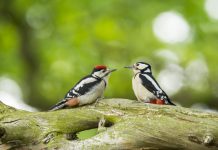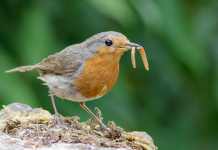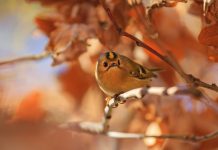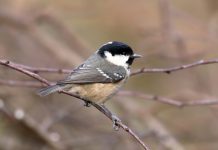In summer, lots of us enjoy nature and wildlife, making bird feeders, building bug hotels, erecting nesting boxes, filling ponds and planting wildflowers. But how do you support birds and wildlife through the winter?
Here are some expert tips to help you continue the good work and enjoy a connection with nature through the cold months ahead.
What to feed birds in winter
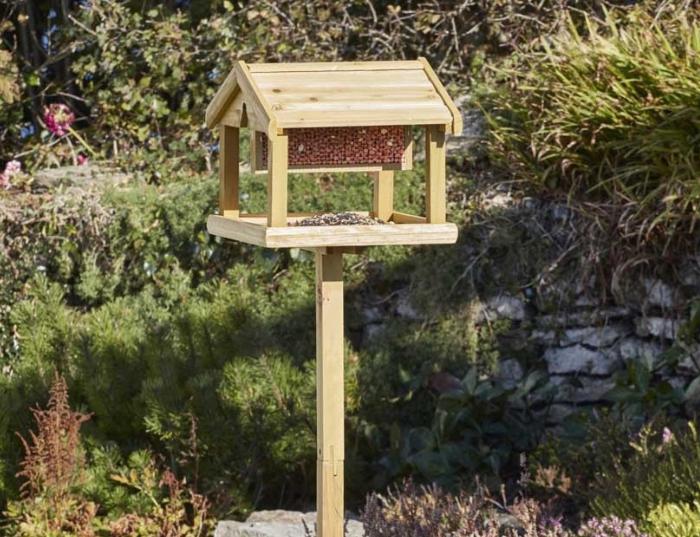
Image: Premium Bird Table with Built-in Feeder from Happy Beaks
Nuts, seeds, mealworms, fat balls and more – these are all great ways to keep birds happy and well-fed during the coldest winter months when natural food sources are scarce. But do make sure you get the right food and present it in the right way.
George Hassall at Green Fingered George says “you should aim to provide a range of different foods, including fat blocks, mixed seeds and peanuts to cater for all types of garden birds. Some birds like to eat from a table and some seed falls to the ground, which is great for our cheeky garden robin!”
Beth Otway, a.k.a. Pumpkin Beth, says going into winter, her feeders are full of fatty, nutritious sunflower hearts, but she also puts out smaller seed feeders filled with shiny black Niger seeds: “Purchasing these seeds is a great way to invite goldfinches into your garden. I’ve also hung up coconut halves that are filled with a mixture of suet and seed and I’ve got fat balls in feeders, too.”
A crafty idea for involving children in feeding the birds comes courtesy of Gemma at Thimble and Twig. Her bird seed shapes are simple to make using seed, gelatine, and cookie cutters – the birds are sure to love them just as much as the kids will enjoy making them.
Remember to keep your bird feeders clean, says the team at RSPB, to reduce the spread of disease. They recommend “cleaning them once a week with a mild detergent solution, such as washing-up liquid. Remember to wear gloves and get rid of any unused or mouldy food.” Another vital service you can perform to help birds survive winter is to provide fresh water for drinking and bathing, checking regularly that it’s not frozen.
Over at Yorkshire Wildlife Trust, the team suggest growing plants and flowers to sustain birds in the cold. They say “dried seed heads from teasels, sunflowers and thistles provide a great source of nutrition during the winter months, as do berried bushes such as holly and ivy.”
How to care for bees in winter

Image: hefei/Shutterstock
Honey bees are the only bees that are actually active throughout the winter, explains Jean Vernon of Addicted to Bees. But while honey bees will venture from their hives to forage on sunny days, “the other 275 species of bees hunker down for the winter.”
You can help active bees by making sure your planting scheme includes varieties that bloom late into the winter and others which bloom very early in the spring. This ensures that these essential pollinators have something to feed on.
There’s a lot you can do to help hibernating species too, Jean says. “It’s not the cold that kills overwintering bees; it’s the damp. So if you have an insect house or bee box where you know there are developing solitary bees, bring it into the protection of a cool, dry, unheated shed or garage until February or March.”
In fact, many species of bee and other pollinators overwinter in a dormant state in compost heaps, leaf litter, piles of prunings, and other crevices and corners throughout the garden. In many ways, the best thing you can do to help, is to do as little as possible! As Green Fingered George says: “We’re not too tidy in the garden, we leave dry plant stems and seed heads, which provides shelter for all kinds of insects. When we cut them in spring, we leave them in a stack until towards the end of the season, to allow the overwintering insects to emerge.”
Winter is a quiet time in the garden, and your efforts to protect wildlife should be low key too. As long as our native species have adequate shelter, food and water, chances are they’ll be fine. Less is more. As Catherine at Growing Family says: “Leaving a border intact rather than cutting down dead plants provides seed heads for birds to feed on, and fallen stems for small mammals, frogs, toads and insects to shelter in. Seed heads also look magical on a frosty winter morning, so there’s an added bonus for us too.”
How to care for mammals in winter
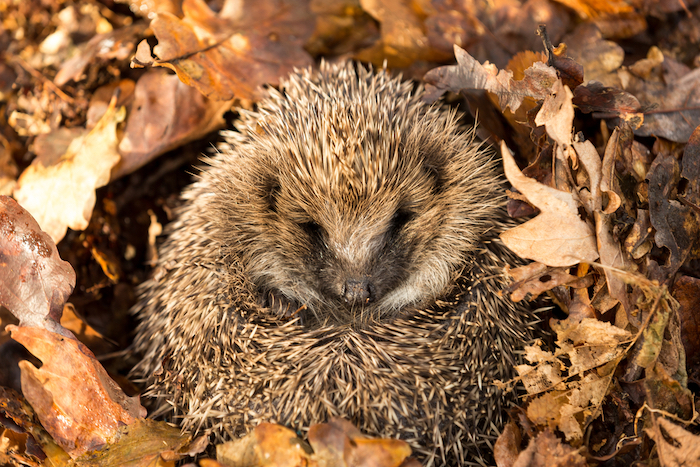
Image: Coatesy/Shutterstock
Whether you should give mammals a helping hand during the winter is somewhat contentious. As Nick Martin of All Things Wildlife says, “encouraging badgers into the garden can be delightful but remember that they can be quite destructive in their search for food and they’re often guilty of peeling up lawns to reach worms and other grubs.”
In some areas, urban foxes are a pest and, Nick says, squirrels will also dig holes in your lawn to bury nuts. He recommends using “caged squirrel proof feeders to prevent them reaching whole nuts and cut down on this behaviour.”
If you do decide to feed visiting mammals, make sure you research to find out what they should eat, because though they might very much enjoy what you put out for them, just like humans, what we like to eat is not always good for our health! Nick says, “hedgehogs, for example, love dried mealworms but studies have shown that they’re not good for them and there are better alternative foods.”
If you want to support local hedgehogs, the team at Songbird Survival say that “minced meat, fresh liver, tinned dog food (not fish based), or even scrambled eggs appeal to these prickly creatures.” They recommend putting it out under a ridge tile or buying a hedgehog house so that only hedgehogs can get in. Otherwise cats, dogs and foxes are likely to steal it.
Speaking of hedgehogs, these are one of a few species that go into full hibernation during the depths of winter. Make sure you think carefully before disturbing log piles, bundles of sticks, your compost heap – you don’t want to wake a snoozing hedgehog.
How to care for pond life in winter

Image: Green Fingered George
Frogs, toads and newts, plus aquatic insects and molluscs retreat to the depths of your pond or the surrounding vegetation and leaf litter during winter. But unlike hedgehogs, they’re often dormant rather than in a state of total hibernation and will need to feed every so often. With this in mind, make sure any pond maintenance is low-impact.
Nick at All Things Wildlife says, “try to limit the disturbance to less than half of the pond [and] leave cleared plants on the side for a day or so, so creatures can wriggle back into the water. This will then limit the impact on aquatic invertebrates and amphibians. If you need to drain the pond for maintenance then try to keep plenty of vegetation and water aside to put back in once the work is done and the water has had a chance to settle again.”
It’s also vital to prevent your pond from freezing over completely. Amphibious creatures need to be able to exit and enter the pond, but also, there’s the issue of poisonous gasses which form from decomposing plant material. If ice traps gasses in the pond, it can poison the fish and other creatures living in it.
Taking care of garden wildlife during the winter months is a great way to ensure that when spring finally arrives, you’ll enjoy witnessing all the frantic activity as the birds, bees, bugs, mammals, amphibians and fish gear up for a busy breeding season.
Lead image: Katniss studio/Shutterstock



